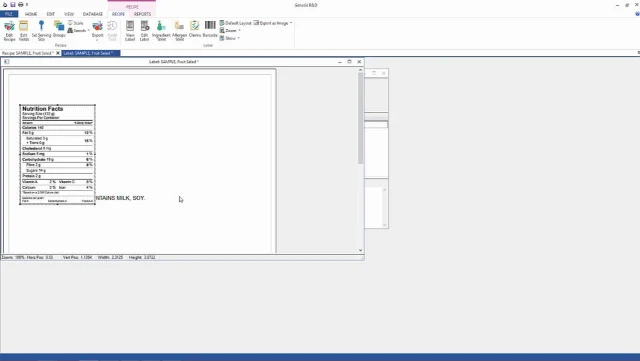Navigating the intricacies of food labelling regulations in Canada is essential for ensuring compliance and building consumer trust. Health Canada mandates that prepackaged foods provide clear and comprehensive Nutrition Facts tables, ingredient lists, and allergen statements. These regulations are designed to help consumers make informed dietary choices, ensure transparency, and protect those with food allergies and intolerances.
Note: This article was originally published on July 7, 2023, and was updated on June 27, 2025, and October 9, 2025.
In addition to these requirements, Canada has introduced front-of-package (FOP) nutrition labelling requirements to help consumers quickly identify foods high in sodium, sugars, and saturated fats. This initiative aims to provide at-a-glance information that encourages healthier food choices.
By leveraging tools like Genesis Foods, manufacturers can simplify the process of creating compliant labels that meet Canadian standards.
Nutrition Facts Tables Formats
 To ensure compliance with Canadian nutrition labelling regulations, it is essential to include specific nutrient information on your product labels. The following nutrients are considered the “core nutrition information” which is mandatory for most Nutrition Facts tables unless an exemption exists. Calories, Fat (Saturated Fat, Trans Fat), Cholesterol, Sodium, Carbohydrate, Fibre, Sugars, Protein, Potassium, Calcium, and Iron. Note: Additional nutrients may be required per the regulations, for example, if a nutrient content claim is made.
To ensure compliance with Canadian nutrition labelling regulations, it is essential to include specific nutrient information on your product labels. The following nutrients are considered the “core nutrition information” which is mandatory for most Nutrition Facts tables unless an exemption exists. Calories, Fat (Saturated Fat, Trans Fat), Cholesterol, Sodium, Carbohydrate, Fibre, Sugars, Protein, Potassium, Calcium, and Iron. Note: Additional nutrients may be required per the regulations, for example, if a nutrient content claim is made.
Genesis Foods simplifies the process of creating accurate Nutrition Facts tables, guiding you through Health Canada’s regulatory standards. Users can input their product nutrition information, and the software automatically calculates nutrient values and formats the information according to the regulations.
Label Formats in Genesis Foods
In Genesis Foods, you can create a variety of Health Canada Compliant Nutrition Facts tables. Each format is designed to fit different packaging sizes and shapes, ensuring clear and accessible nutritional information for consumers. 
-
- Standard Vertical Labels: The most common format for packaged food products, featuring a simple and effective layout for easy reading. This format is recommended unless space is limited.
- Horizontal (Tabular) Labels: Ideal for products with limited vertical space or wider packaging, such as beverage cans or elongated packages.
- Linear Labels: Suitable for narrow or vertically long packages, like spice jars or stick packs, arranging nutritional information in a linear fashion.
- Dual Format Labels: This label type is applicable for foods requiring preparation prior to consumption or foods that are customarily served combined with other foods, to help the consumer differentiate between the nutrition facts information of the food as sold and as prepared.

- Aggregate Labels: This kind of label format must be used for different kinds of foods in a single package, as in a variety pack, if the Nutrition Facts information differs among the varieties in the pack. It can also be optionally used in cases where the label displays more than one amount of the same food.
Each of these formats in Genesis Foods allows you to maintain compliance with the latest Canadian regulations, supporting both single and bilingual labelling needs, and providing additional options for displaying optional nutrients.
Choosing the Right Format
Health Canada and CFIA outline “families” of formats (standard, simplified, linear, dual, and aggregate) and choosing the correct format for your recipe depends on product type, serving context, and package constraints.
Begin by asking whether you’re declaring one food or more than one on the same panel. If you’re combining distinct items in a variety pack or kit, you’ll typically use an aggregate format that shows separate columns for each food. If you’re selling a single food but want to present two amounts on the same label (for example, one slice and two slices), you’ll use an aggregate or dual variation for different amounts. Genesis Foods supports both cases under the Canada authority.
If you have one food and one amount, consider preparation. When the consumer meaningfully changes the food before eating—think “as sold” versus “as prepared”—you’re looking at a dual format so shoppers can compare both states side by side. If preparation doesn’t change the nutrition in a way that matters for the label, you’ll stay with a standard/simplified label type instead.
From there, check package size and space. The regulations permit horizontal, narrow, and linear versions so you can stay compliant even on tight panels. Small packages may qualify for simplified or linear layouts; larger panels usually use standard or horizontal tables. In Genesis Foods, you can switch among these Canadian layouts without impacting your recipe, since the content and %DV logic stay tied to the Canada rules.
Finally, confirm language presentation. Most consumer prepackaged foods require mandatory information in both English and French. Choose a bilingual table unless you fall under a specific exemption, then preview the result with your chosen format. Genesis Foods provides monolingual and bilingual versions for each Canada layout
Creating Accurate Ingredient Lists
Accurate ingredient labelling is critical for compliance with Canadian food labelling regulations. In general, the list of ingredients must be headed by the word “Ingredients” and listed by weight in descending order. For products that contain more than one sugar-based ingredient, the regulations require all sugar-based ingredients to be grouped together in the ingredient list. These ingredients must be listed in descending order within parentheses after the word "Sugars/Sucres," with their combined weight determining the group's order.
Ingredient List Example:
|
Ingredients: Sugars (fancy molasses, brown sugar, sugar), Flour, Vegetable oil shortening, Liquid whole egg, Salt, Sodium bicarbonate, Spices, Allura red |
Genesis Foods automates the creation of accurate ingredient lists by calculating the weight of each ingredient in your recipe and automatically listing them in order of predominance. Each ingredient designated as “sugar” will be grouped in the ingredient statement.
Protecting Consumers with Allergen Statements
Proper allergen labelling is essential to protect consumers with food allergies and intolerances. Canadian regulations require that ingredients or additives causing hypersensitivity, intolerance, or allergic reactions be declared, headed by the word "Contains."
 Major allergens that must be declared include:
Major allergens that must be declared include:
- Crustacean*
- Eggs
- Fish*
- Gluten (Barley, Oats, Rye, Triticale, Wheat)*
- Milk
- Mollusc*
- Mustard/Mustard Seed
- Peanuts
- Sesame/Sesame Seed
- Soy
- Sulphites (10 ppm or more)
- Tree Nuts*
- Wheat/Triticale
*Must list the specific species or type for Crustacean, Fish, Mollusc, and/or Tree Nuts
Genesis Foods is pre-loaded with all required allergens and guides users through the ingredient and recipe creation process to review them, ensuring all potential allergens are clearly and correctly identified. This automation minimizes errors, ensures compliance with Canada labelling regulations, and enhances consumer safety and trust.
Supporting Compliance with Genesis Foods
Using Genesis Foods, you can streamline the process of creating compliant labels. Genesis Foods provides enhanced capabilities for label creation under Canadian regulations, including the Canadian Adult Recommendation Profile and bilingual labelling options. This comprehensive approach ensures your food labels meet Canadian standards, offering clear and accurate information to your consumers. By leveraging the tools in Genesis Foods, you can simplify the label creation process, and enhance regulatory compliance, making navigating the complexities of Canadian food labelling a more straightforward and efficient process.
















Other posts you might be interested in
View All Posts
Food Industry
17 min read
| November 13, 2025
Top Takeaways from reCONNECT 2025: Building a Smarter, Safer Food Industry
Read More
Food Industry
5 min read
| October 21, 2025
reCONNECT 2025 | Trustwell Connect: How Far We've Come
Read More
Food Industry
4 min read
| October 17, 2025

